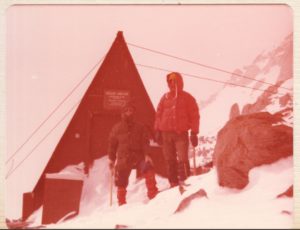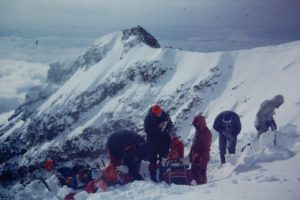When you’re dreaming of climbing Mount Rainier, the standard advice is to be in the best shape of your life. That’s true!
But let’s talk about making your trip even more meaningful, shall we? Decades later, I can still look back on the ascent of Mount Rainier as the adventure of a lifetime. What was so special was that I was able to experience that climb. That won’t make sense, yet – I’ll explain.
A typical climb is quick. Get up, get down, enjoy the view. It’s exhausting. It’s a big mountain. Your pack is heavy. The air gets thin. There will be issues: sunburn, weather, cold, wet, wind, blisters, symptoms of altitude sickness. It’s often a fast pace. At the least, it will feel fast because so much is happening at once. Sure, you’re on foot, one step at a time (or possibly on board or skis). It looks slow. but that first time on The Mountain you won’t be relaxed, finding your balance, being one with the experience.
Or will you? That’s where the mental/emotional preparation comes in. The more you know, the better you are prepared, the more fully you will be able to enjoy the trip itself, whether you make the summit or not. About half the summit attempts per year are successful.
There are two ways to climb Mount Rainier
– through one of the three mountaineering guide services, or as a private party with a climbing permit. Every person sleeping at, or climbing above, the high camps (e.g., Camp Muir) must have a permit issued by the National Park Service. I’ll talk about mentally preparing for both types of climbs.
If this is your first time on the glaciers of Mount Rainier, you’ll undoubtedly be traveling with at least one far-more-experienced person. It’s human nature to leave the planning and preparation to that person (probably the trip leader). Now is the time for you to learn and plan as much as you can.
Mount Rainier: A Climbing Guide (3rd Edition) by Mike Gauthier is the place to start. Mike, now Chief of Staff for Yosemite National Park, “has summited Rainier more than 180 times via more than 30 different routes and variations in all seasons and manner of conditions.” Mike tells us about the mountain itself – weather, safety and survival, the nature of glaciers and avalanches. This is the sort of preparation I recommend: do your best to understand the mountain.
Can you learn the mountain from a book? Of course not. If you possibly can, visit Mount Rainier National Park before your climb. Stay below timberline. Learn what the Park as a whole has to offer. Work to understand the ecosystem.
When wife Susan and I returned to Mount Rainier National Park September 2017, we stayed just outside the park entrance. We drove over to the Ohanapecosh entrance, crossed the campground, ate a picnic lunch along the river bank. We could observe the birds, the chipmunks, the river gravel. The trees and vegetation changed as we gained and lost elevation. This is where you’ll find those thousand-year-old trees in the Grove of the Patriarchs.
Ohanapecosh (to the southeast) is drier and sunnier than Longmire and Paradise (south and southwest). Is the reason obvious? Possibly not!
The most important deciding factor for your upcoming climb is the weather. Mount Rainier quite literally creates its own weather. Do everything you can to understand that weather! East of the crest of the Cascade Mountains (including Rainier) will be drier. The moist air moves west to east. When it hits the mountain range it rises, causing it to drop its moisture as precipitation. When it’s wet and soggy to the west it can be dry to the east.
As you hike around the park, note your surroundings. Note those glaciers up above, picture how they form and how they move. Understand how the crevasses form as the glacier flows over a rise. You might end up in one of those very crevasses! Even when it’s sunny up top, those crevasses are cold inside. It’s a serious life-threatening cold. Be mentally prepared for that.
I suggest the three “P”‘s: Planning, Preparation, Practice. Hopefully, you have the “planning” part figured out! My skills are not current, so I’m not qualified to tell you about preparation. The classic mountaineering text is Mountaineering: The Freedom of the Hills (9th Edition). To give an idea of how important the book is, I have the 2nd, 3rd, and 8th editions, heavily used!
You have two aspects of physical preparation: conditioning and technical skills. The technical skills are covered in Freedom but of course, you’ll need to learn from someone in person to ensure you got it right. Lives depend on that. For conditioning, I personally use The Outdoor Athlete by Courtenay Schurman and Doug Schurman. They include a specific training program for a typical 2-3 day ascent of Mount Rainier. The book includes training specific to hiking, climbing, trail running, skiing, etc.
But how do you actually prepare when you don’t live anywhere near Mount Rainier National Park? Work from your strengths. Work from the known to the unknown.
For example, you’re good at hiking. Consider ways you could “kick it up a notch.” How about taking a night hike, and leaving your flashlight off the entire time? No cell phone, no GPS unit. Can you learn to discern different sounds, understand and predict the terrain?
By the by, there’s a good reason to learn to hike at night without artificial light. It’s called the “alpine start.” Leave camp at midnight, 3 AM, or similarly ridiculous time before dawn to head for the summit. The general idea is to hit the summit just after sunrise and be back down off the glaciers by noon or so. Naturally, trips don’t always work precisely as planned! The afternoon sun weakens (melts) the snow and increases the likelihood of falling into a crevasse.
Traveling down from the summit, in my experience, is more dangerous than climbing to that summit. You’re tired. Your knees and ankles are not used to that type of load. The steps down a steep slope are jarring. The snow is weakening. That’s when the mishaps happen. Don’t “zone out” on the way down; pay close attention and be at the top of your game descending!
My own skills are not current, though I’m working on that. That’s why I’m not giving any specific climbing advice. We’re focused on the mental aspects of more greatly enjoying the experience.
Gain experience by climbing other glaciated peaks. I was trained by The Mountaineers, including a practice climb of Mount Saint Helens (9677′) before it blew up. Dad and I climbed Mount Olympus (7965′) from the Hoh River. A week later we (eight of us) attempted Mount Rainier’s Tahoma Glacier from the West Side Road. On the third day, “The Sickle” avalanched beneath our noses. We discussed this remarkable event as the weather worsened and turned back.
 Two months later, September 1974, Dad and I (and six others) attempted Mount Rainier via Camp Muir, Cathedral Rocks, Ingraham Glacier, Disappointment Cleaver, Emmons Glacier. We slept at Camp Muir, up at 1 AM and leaving at 2:30 AM for the summit. We were climbing by moonlight. The wind and snow started at 8 AM.
Two months later, September 1974, Dad and I (and six others) attempted Mount Rainier via Camp Muir, Cathedral Rocks, Ingraham Glacier, Disappointment Cleaver, Emmons Glacier. We slept at Camp Muir, up at 1 AM and leaving at 2:30 AM for the summit. We were climbing by moonlight. The wind and snow started at 8 AM.
We, a small private party, followed a guided party. We couldn’t keep up! Be prepared for that fact: the guided parties move up the mountain fast. We reached the crater rim, 14,200 feet elevation. I was not able to make my teeth stop chattering.
That’s a warning sign of severe hypothermia. I knew that, thanks to The Mountaineers’ training, and informed someone. After that I basically “lost it” and let someone else rummage through my pack, getting me into warm dry clothes. Still, on a rope, I stumbled my way down the mountain.
Don’t let yourself get exhausted from a severe head cold! When you try to “tough it out” you may endanger the entire party and not just yourself. We descended in a snowstorm and white-out. The previously-placed wands (navigation markers) were vital.
By the time we reached Paradise once again, at 9:30 PM it was raining. We’d been up since 1 AM. That’s a typical summit attempt. I’d now been blown off the mountain twice, having reached the crater rim once.
Two and a half years later, on a Saturday morning in March 1977, Dad and I and six others checked in at the Paradise Ranger Station for our climbing permits. What with the wind and snow, there was no waiting! We left Paradise at 11:40 AM on snowshoes, placing wands from the parking lot onward. We nearly had the mountain to ourselves – or so it felt at the time. We each carried 65-70 pound packs. We arrived at Camp Muir at 7 PM, traveling in white-out and wind most of the day. We needed to shovel out the door to get in the shelter. We stayed hunkered down the entire next day, those thick stone walls vibrating from the wind. None of us wanted to leave that hut for any reason, especially not for any calls of nature!
Our third day saw us to high camp at 12,300′, high on the Ingraham Glacier. Our tents nearly collapsed from the 3-4 feet of new snow overnight. We made the summit and back to high camp on day four and most of us slept in a snow cave that night. It was remarkably calm, quiet, and warm! Our fifth day saw us down and off the mountain in the ongoing white-out.

Here we are packing up high camp the next morning. It took us two hours to dig out all of our equipment after the storm. Note Mount Adams in the distance at top right. At 12,281′ its summit is exactly even with us at 12,300 feet elevation.
There’s much to be said for the more relaxed pace of a winter experience on the glaciers of Mount Rainier. The key, once again, is planning, preparation, and practice. That’s why I told you my ancient story, so you could understand what I mean when I talk about all of those other ways to prepare, so as to better enjoy the experience. What I learned on Mount Rainier in the winter, you can apply to your trip during the summer.
I, too, dream of hiking up Mount Rainier one more time. I plan to walk up to Camp Muir – just the day hike – safely, with proper equipment, preparation, and companions. That’s my practice run. I’m not a teenager anymore! I plan to be ready for a summit climb before walking up to Camp Muir. I plan to experience the hike and in a good way. If stuff happens, such as the weather coming in, I plan to have plenty in reserve, and the skill/resources to safely navigate in a whiteout.
You and I are different people. Your plan will be different from mine. I invite you to look at the mental/emotional aspects of that plan, and of the dream trip itself. What can you do, what can you experience, for the best?
Written by guest blogger Ed Barnard
ADDITIONAL RESOURCES
For additional information on climbing permits at Mount Rainier National Park click here.
For additional information on guide services visit:
